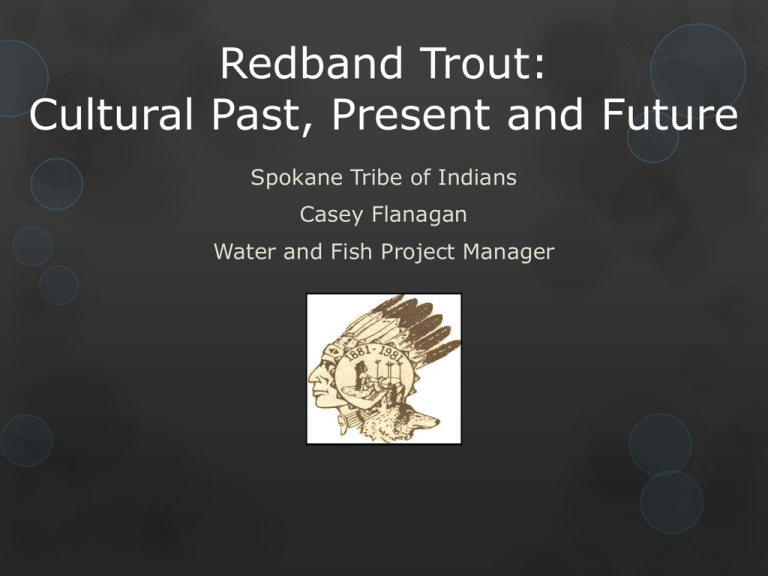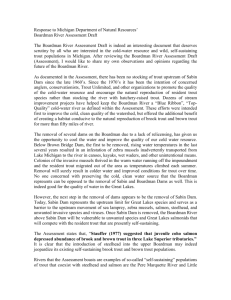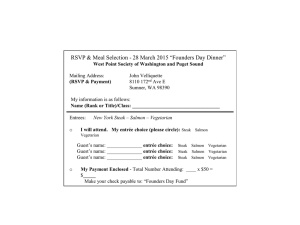
Redband Trout:
Cultural Past, Present and Future
Spokane Tribe of Indians
Casey Flanagan
Water and Fish Project Manager
Redband Trout
Remnants of steelhead populations
Salmon cannery overharvest
Construction of dams
Multiple life history strategies that allow multiple spawning
migrations per year
Fluvial: Resident
Fluvial-adfluvial: tributary -> river -> tributary
Lacustrine-adfluvial: tributary -> lake -> tributary
Allacustrine: Spawn in lake outlet
Spokane Tribe: The Salmon Eaters
At least 90% of the Spokane
Tribe’s animal caloric intake was
from fish.
Called themselves “salmon
eaters” or “people who eat
salmon”
Most eastern tribe to
extensively use salmon in their
diet.
Named their villages and subbands after a specific fishery,
condition of water or a specific
species of salmon
Spokane Tribe: The Salmon Eaters
At least 90% of the Spokane
Tribe’s animal caloric intake was
from fish.
Called themselves “salmon
eaters” or “people who eat
salmon”
Most eastern tribe to
extensively use salmon in their
diet.
“Eleven salmon trout caught in
halfdays sport on the Spokane
River” - Spokesman Review
Publications 1896
Named their villages and subbands after a specific fishery,
condition of water or a specific
species of salmon
The Spokane’s “salmon” were
actually salmon, steelhead and
trout.
Relied heavily on salmonids and
other native fish year round.
The Spokane River
“The Spokane River was known worldwide, as one of the finest
trout rivers in the world.” – Marshall McDonald 1894
Multiple weirs and basket traps
on the Spokane River and its
tributaries produced up to 800
fish per day
Little Spokane River was known
for steelhead and resident trout
Up to 200 fish caught per day
Permanent fishing spot
Little Falls was one of the last
permanent fishing stations
Fishery started in early spring for
steelhead, resident trout,
lamprey, suckers
At least 250 tons of dried fish in
one season
Redband Trout Stock Assessment
Understand population
characteristics for
individual stocks
Genetic Integrity
Recruitment
Alder
Orapaken
Mortality
Escapement
Blue
Harvest
Evaluate negative
interactions with redband
trout
Hatchery-stocked coastal
rainbow trout
Non-native fish
Identify critical spawning
and juvenile rearing
habitat
Spring
Spokane
Redband Trout Stock Assessment
Summer Habitat Surveys
Pool/riffle ratios
Large woody debris
Vegetative cover
Wolman pebble counts
Temperature loggers
Water depth and flow
Invertebrate surveys
Fall Electrofishing
Population density
Age
Genetics
PIT tag
Redband Trout Stock Assessment
Spring Trapping
Adult Spawning Migration
Sex ratios
Maturity
Age
Genetics
PIT tag
Juvenile Out-Migration
Ratio of out-migrants to
residential population
Distance of outmigration
Growth
Age
Genetics
PIT tag
Redband Trout Stock Assessment
PIT (Passive Integrated Transponder) Tag
Locations
Body Cavity
Pelvic Girdle (between pelvic fins)
Unique 15 digit code for each fish
Redband Trout Stock Assessment
PIT (Passive Integrated Transponder) Tag
Locations
Body Cavity
Pelvic Girdle (between pelvic fins)
Unique 15 digit code for each fish
Allows biologists to track fish without being in the field
PIT tag antennas
PIT tag handheld readers
Biologists
Creel Clerks
Future Goals
Identify streams that contain
redband trout
Classify genetically pure
redband trout populations
Prioritize streams that contain
native redband trout for
habitat improvement projects
Understand movement of
redband trout in the reservoir
and tributaries
Evaluate if native redband
trout populations are in
decline or maintaining stable
recruitment
Acknowledgements/Cooperative Partners
Bonneville Power Administration
Avista Corporation
Lake Roosevelt Fisheries Evaluation Program
Eastern Washington University
Colville Confederated Tribes
Washington Department of Fish and Wildlife
Kalispel Tribe
Warren Seyler
Jimbo Seyler
Questions?












